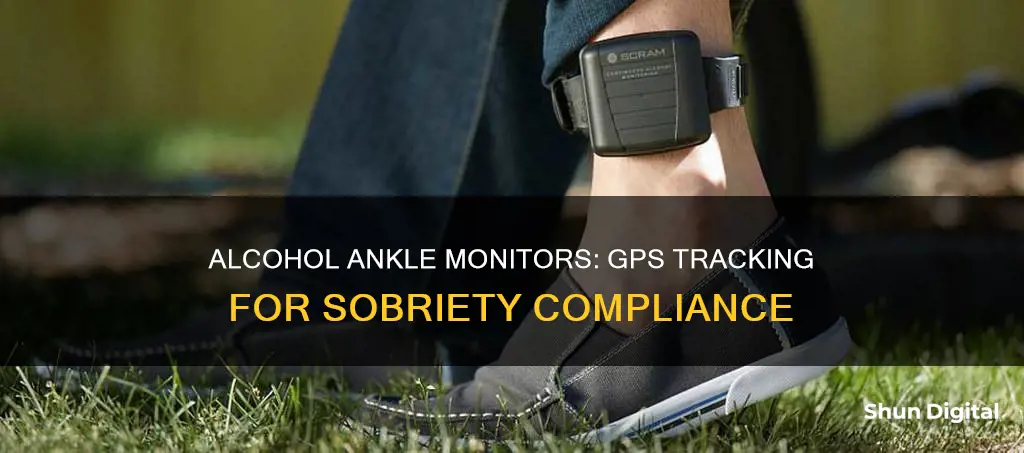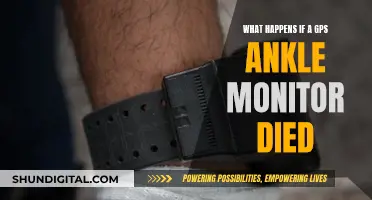
Alcohol ankle monitors, also known as SCRAM bracelets, are commonly used to monitor the sobriety of individuals on probation or pretrial release. While the primary function of these devices is alcohol detection, some have raised questions about their GPS capabilities. This paragraph aims to explore the topic of GPS integration in alcohol ankle monitors, addressing their features, limitations, and relevance to the criminal justice system.
| Characteristics | Values |
|---|---|
| Name | SCRAM (Secure Continuous Remote Alcohol Monitoring) |
| Purpose | Monitor alcohol consumption and location |
| Target Group | Offenders who are not supposed to be drinking alcohol |
| Common Uses | DUI cases, domestic violence cases, underage drinking cases, substance abuse cases |
| Duration | 60 or 90 days, or longer as a term of probation or parole |
| Wear Time | 24/7 |
| Detection Method | Sampling perspiration every 30 minutes |
| Alert Mechanism | Reports positive test results to the monitoring company, who then notifies the court |
| GPS | Yes |
| RF | Yes |
| Installation Fee | $50 to $100 |
| Daily Monitoring Fee | Around $10 to $15 |
| Monthly Cost | Up to $450 or more |
What You'll Learn
- SCRAM bracelets are court-ordered for DUI cases and other types of cases involving alcohol
- SCRAM bracelets are also used in cases of domestic violence, underage drinking, and substance abuse
- SCRAM bracelets are equipped with GPS locators for offenders on house arrest
- SCRAM bracelets are highly accurate in detecting alcohol consumption
- SCRAM bracelets are not foolproof and may be incompatible with certain medical conditions

SCRAM bracelets are court-ordered for DUI cases and other types of cases involving alcohol
SCRAM bracelets, or Secure Continuous Remote Alcohol Monitoring bracelets, are often court-ordered for those convicted of driving under the influence (DUI) or driving while intoxicated (DWI). They are also used in other cases where the offence involved drugs or alcohol, or where the offender has a history of substance abuse.
In DUI cases, judges are often concerned about the possibility of recidivism, and a SCRAM bracelet is one of the tools they can use to guard against this. A SCRAM bracelet can be ordered by a judge as a pretrial condition of release from jail, or after conviction as a condition of probation. They are most commonly ordered for repeat and high-risk offenders, and for those who have shown a severe problem with alcohol.
SCRAM bracelets are ankle or wrist devices that detect and report the alcohol consumption of the wearer by measuring the concentration of alcohol in their perspiration. They are designed to take samples of sweat at regular intervals, usually once an hour or every 30 minutes. The device then transmits these readings to a monitoring service provider, who converts the transdermal concentration to a blood alcohol concentration (BAC). If a reading indicates the wearer has been drinking, the court is notified.
The cost of a SCRAM bracelet typically includes an installation fee of $50 to $100, and daily monitoring fees ranging from $10 to $15, which can lead to monthly costs of $300 or more. Usually, it is the defendant who pays these fees.
In addition to DUI cases, SCRAM bracelets may also be court-ordered in other types of cases where alcohol use is a concern. For example, a judge might order a SCRAM bracelet for parents in family court, domestic violence cases, underage drinking cases, and cases involving charges related to substance abuse.
Monitoring Memory Usage in Embedded Linux: Practical Tips
You may want to see also

SCRAM bracelets are also used in cases of domestic violence, underage drinking, and substance abuse
SCRAM bracelets, or Secure Continuous Remote Alcohol Monitoring bracelets, are often used by courts to monitor offenders who are not supposed to be drinking alcohol. While they are most commonly used in cases where the defendant has been convicted of driving under the influence (DUI), SCRAM bracelets are also used in cases of domestic violence, underage drinking, and substance abuse.
In cases of domestic violence, SCRAM bracelets provide 24/7 transdermal alcohol testing for high-risk alcohol caseloads. By automatically sampling the wearer's perspiration every 30 minutes, the SCRAM bracelet eliminates testing gaps and encourages accountability. This not only supports sobriety but also results in higher compliance rates with court orders and increases community safety.
SCRAM bracelets are also used in cases of underage drinking. Courts may order these alcohol-monitoring ankle bracelets when there is a problem with alcohol use by minors. For example, a judge might order a SCRAM bracelet for parents in family court. The bracelet is designed to detect alcohol and any kind of tampering, with the monitoring company reporting any such instances to the court or probation department.
In cases of substance abuse, SCRAM bracelets can be ordered by the court for a set period of time, typically 60 or 90 days, or for a longer period as a term of probation or parole. The bracelets help support long-term behaviour change and complement treatment for alcohol dependence or addiction. The continuous alcohol monitoring provided by SCRAM bracelets has been proven to help more people achieve more sober days and encourage compliance with court orders.
Degaussing an LCD Monitor: Simple Steps to Success
You may want to see also

SCRAM bracelets are equipped with GPS locators for offenders on house arrest
SCRAM bracelets, or Secure Continuous Remote Alcohol Monitoring bracelets, are often equipped with GPS locators for offenders on house arrest. This technology allows authorities such as courts and probation departments to monitor the offender's location and ensure they abide by the terms of their house arrest.
The SCRAM bracelet is an alcohol-monitoring ankle bracelet that provides a way for courts to supervise offenders who are prohibited from consuming alcohol. While SCRAM bracelets are most commonly used in cases involving driving under the influence (DUI), they are also ordered in other types of cases where alcohol use is a concern, such as domestic violence, underage drinking, and substance abuse charges.
The bracelet works by monitoring the wearer's perspiration every 30 minutes. When a person consumes alcohol, a portion of it is metabolized and excreted through the skin as sweat. The SCRAM device detects the presence of alcohol on the surface of the skin at the ankle. These measurement results are then uploaded and monitored by a private company, which reports any positive alcohol tests to the court.
In addition to alcohol detection, SCRAM bracelets can also detect any tampering attempts. If an offender tries to remove or interfere with the bracelet, the monitoring company is notified, and they, in turn, report the tampering to the court or probation department. This can lead to severe consequences for the offender, such as the termination of probation or jail time.
When SCRAM bracelets are used in conjunction with house arrest, the GPS feature becomes particularly relevant. It allows authorities to verify that the offender is adhering to their confinement requirements and staying within the permitted boundaries of their home. This real-time location tracking, combined with alcohol monitoring, provides a comprehensive solution for supervising offenders on house arrest who are also required to abstain from alcohol consumption.
The Evolution of LCD Monitors: A Historical Perspective
You may want to see also

SCRAM bracelets are highly accurate in detecting alcohol consumption
SCRAM bracelets, or Secure Continuous Remote Alcohol Monitoring bracelets, are highly accurate in detecting alcohol consumption. They work by sampling the wearer's perspiration every 30 minutes to test for the presence of alcohol. This method of transdermal alcohol testing is scientifically proven and approved by the Legal Aid Agency.
The SCRAM bracelet's accuracy is due to its ability to differentiate between alcohol consumed by the wearer and external environmental sources of alcohol, such as hand sanitiser or household products containing alcohol. This distinction is made by identifying a sudden peak in alcohol levels, which indicates an environmental factor. Actual alcohol consumption, on the other hand, will show a gradual, curved reading as alcohol levels in the body slowly increase over time.
In addition to its accuracy in detecting alcohol consumption, the SCRAM bracelet can also detect attempts to tamper with or obstruct the device. It is equipped with temperature and infrared sensors, as well as a robust tamper clip, to identify any circumvention attempts.
While SCRAM bracelets are highly accurate, it is important to note that they cannot confirm complete abstinence from alcohol. Even low levels of alcohol consumption (1-2 units) can be detected by the bracelet. Overall, the SCRAM bracelet is a reliable and innovative tool for continuous alcohol monitoring, providing detailed patterns of alcohol use over time.
Easy Guide: Connecting Your Monitor to TW
You may want to see also

SCRAM bracelets are not foolproof and may be incompatible with certain medical conditions
Firstly, let's address the potential vulnerabilities of SCRAM bracelets. Although they employ advanced technology, including transdermal alcohol testing and anti-tamper features, there is still a possibility of false positives or negative results. For instance, exposure to certain cleaning agents, hygiene products, or food items containing traces of alcohol can trigger a false positive reading. This means that individuals wearing SCRAM bracelets must be cautious about their surroundings and product usage to avoid any accidental alerts.
Additionally, SCRAM bracelets may not be suitable for everyone due to medical reasons. Certain medical conditions, such as circulation problems, deep vein thrombosis, or metal allergies, may prevent individuals from wearing SCRAM bracelets. In such cases, it is crucial to consult a doctor before attempting to wear any SCRAM bracelet. Furthermore, SCRAM products may not be compatible with medical devices like pacemakers or other implanted devices. The magnetic fields produced by MRI machines and other medical equipment might also interfere with SCRAM products. Therefore, individuals with specific medical conditions or those using medical devices must carefully consider the compatibility and potential risks before using SCRAM bracelets.
Moreover, SCRAM bracelets are designed to be water-resistant, but they should not be submerged in water. The SCRAM GPS bracelets are an exception, as they are submersible up to six feet (two meters). It is important to follow the cleaning and maintenance guidelines provided by the manufacturer to ensure proper functioning and avoid any skin issues.
While SCRAM bracelets provide a valuable tool for monitoring alcohol consumption, it is important to recognize their limitations and potential challenges. By understanding these factors, individuals can make informed decisions and work collaboratively with supervising authorities to address any concerns or incompatibilities related to their specific circumstances.
Guide to Verify Your Monitor's 100Hz Refresh Rate
You may want to see also
Frequently asked questions
Yes, alcohol ankle monitors or SCRAM bracelets can be equipped with GPS tracking. SCRAM stands for Secure Continuous Remote Alcohol Monitoring.
SCRAM bracelets are used to monitor the sobriety of individuals on pretrial release or probation. They are often court-ordered in DUI cases or other cases involving alcohol and drugs.
SCRAM bracelets monitor the wearer's perspiration for alcohol metabolites every 30 minutes. They can detect even small amounts of alcohol and immediately alert the relevant authorities.
Tampering with a SCRAM bracelet will result in severe consequences, such as termination of probation, jail time, or other penalties imposed by the court.
The cost of a SCRAM bracelet typically includes a one-time installation fee ($50 to $100) and a daily monitoring fee (around $10 to $15), resulting in monthly costs of up to $450 or more.







